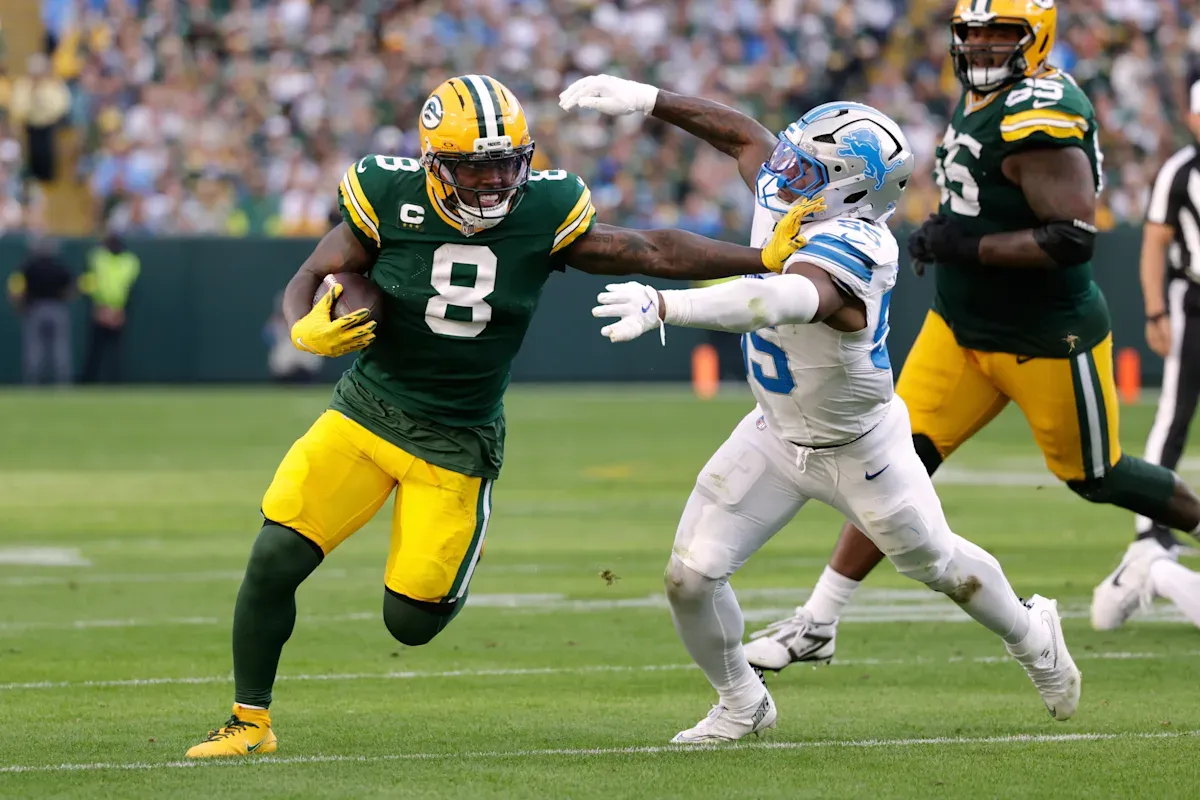
Week 11 Walkthrough: Josh Jacobs, Come Hell or High Water
Welcome to the Week 11 Walkthrough.
In this article, I'll outline critical fantasy football context for the 11th glorious football Sunday of 2025.
(The stats below are from PFF, NFLfastR, rbsdm.com, RotoViz, FantasyLabs, Fantasy Life, Fantasy Points, ESPN, FTN, and NFL Next Gen).
PROE data is available for subscribers at the bottom of the post.
Quick Links
- Packers at Giants, 1 PM
- Bears at Vikings, 1 PM
- Buccaneers at Bills, 1 PM
- Chargers at Jaguars, 1 PM
- Panthers at Falcons, 1 PM
- Texans at Titans, 1 PM
- Bengals at Steelers, 1 PM
- Seahawks at Rams, 4:05 PM
- 49ers at Cardinals, 4:05 PM
- Ravens at Browns, 4:25 PM
- Chiefs at Broncos, 4:25 PM
Packers at Giants, 1 PM
Packers
Implied Team Total: 24.75
The Packers are profiling as one of the most predictable offenses in the league. And I don't just mean for us. If you're playing against them, it has to be relatively easy to figure out the plan you'll be seeing—big picture, anyway. This is a team that's going to try very hard to remain balanced regardless of game script.

Typically, the Packers are operating this way from a position of strength, dictating the run.
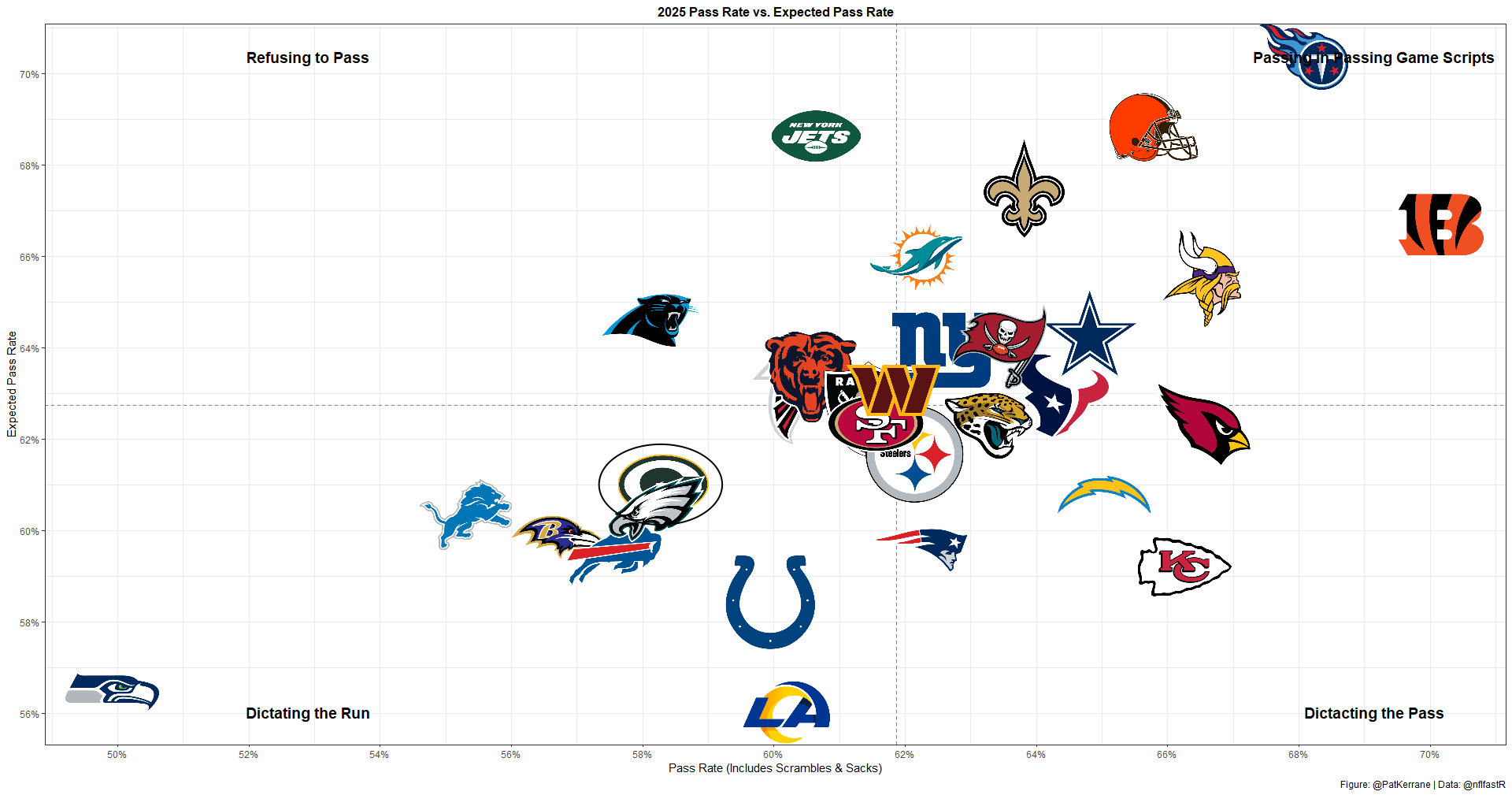
However, as the last two weeks have shown, they'll fight hard against negative script. Matt LaFleur does not look willing to put the game truly on Jordan Love's shoulders.

LaFleur's approach makes more sense when you consider Jordan Love's play over the last couple of weeks. He turned in his lowest success rate of the season (to that point) against the Panthers. He was even worse last week in success rate, while also posting a season-low EPA per play.

Honestly, the Packers' offensive approach is still perplexing. Even with a couple of down games, Jordan Love has been extremely efficient this year.
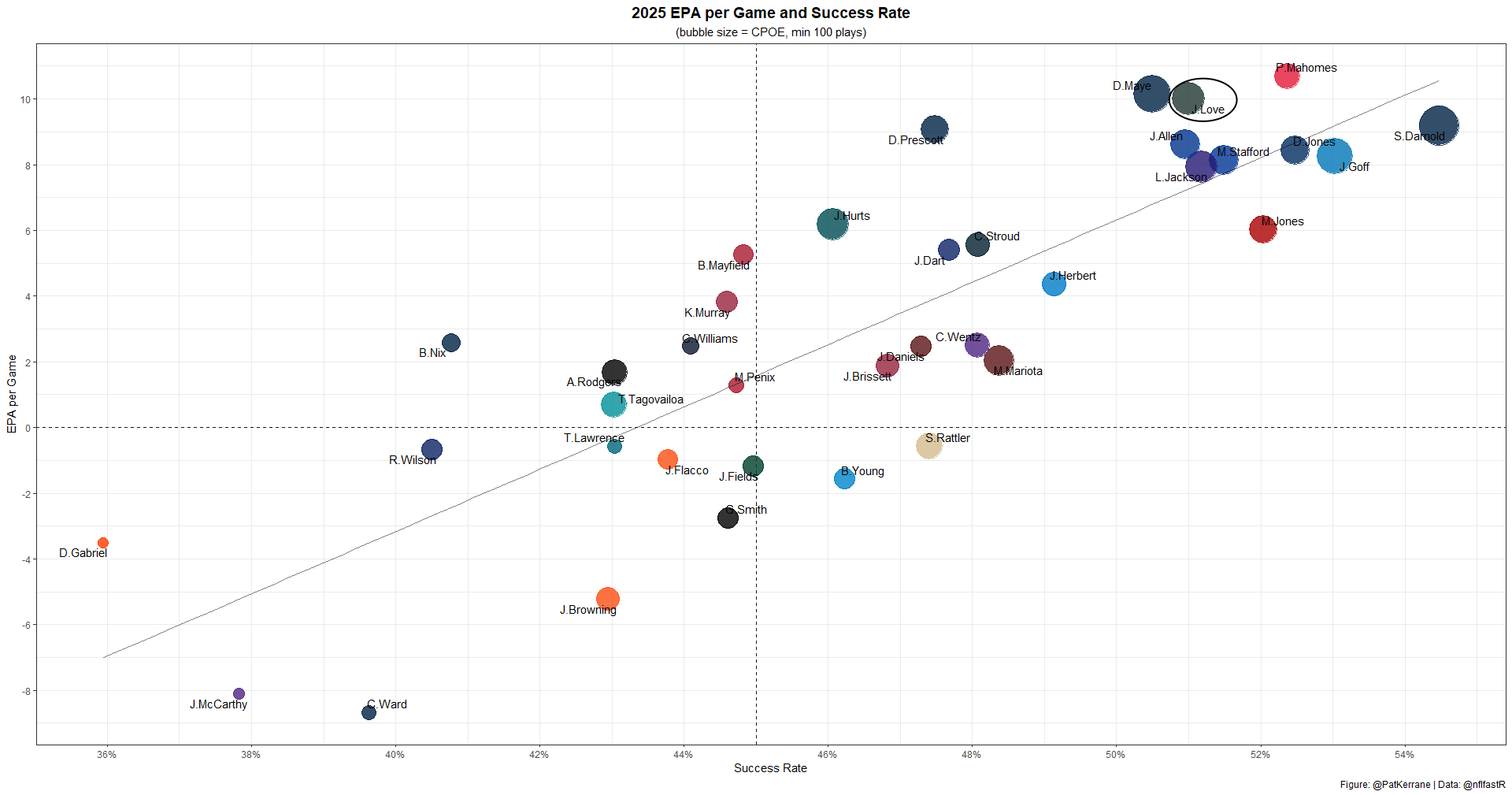
As a runner, Josh Jacobs has not been.
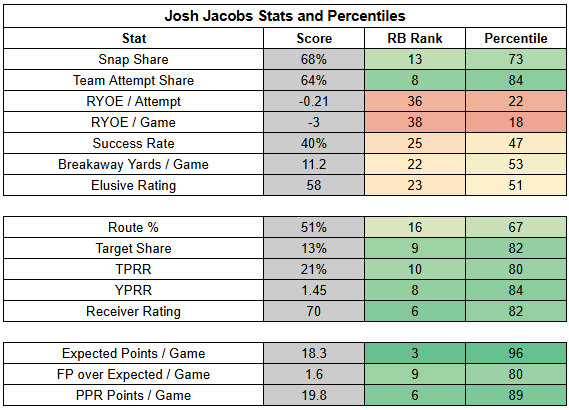
Ironically, Jacobs has been efficient as a receiver, although even then, only by running back standards. 1.45 YPRR is pretty weak if your primary job is to get targeted downfield. That's not a knock on Jacobs; it's a knock on LaFleur for designing his offense around him.
Jacobs' 40% success rate is solid enough. But he just isn't delivering much burst. It just doesn't really make sense to build the whole plane out of Josh Jacobs when you're getting near-league-best efficiency at QB.
But with Jacobs returning to a workhorse role against the Eagles, that's exactly what the Packers are doing.
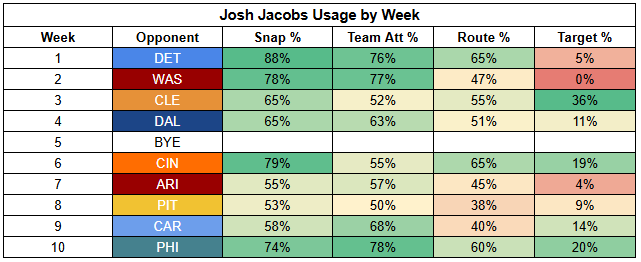
For this approach to make sense, we probably need the Packers to face a genuinely terrible run defense... like, the worst in the league type of bad.
Well, would you look at that.

In this matchup, Matt LaFleur's stubbornness and predictability suddenly become fantasy football assets. The Packers are 7-point favorites here. But they're on the road facing a team that just fired its head coach, making things less predictable. It's nice to know that come hell or high water, LaFleur is going to run the ball on this defense. Jacobs is a high-end RB1.
Even if Jacobs isn't especially efficient this week, the Packers are likely to feel like the Packers again (in a good way). The Giants are also quite poor against the pass and play man coverage at the third-highest rate. Love ranks QB3 in EPA per play against man, with the highest success rate in the league.
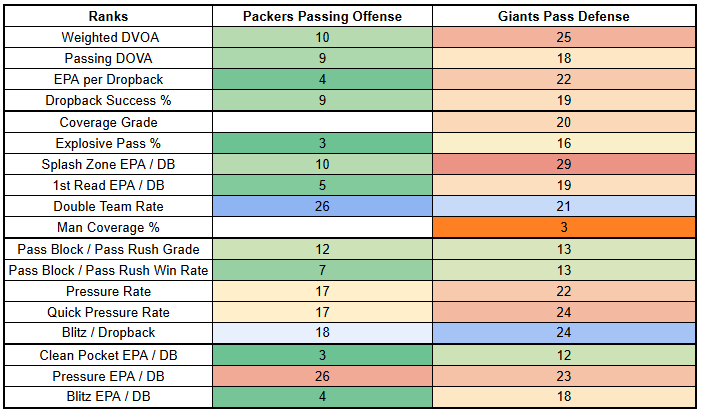
Unfortunately, Tucker Kraft is out for the year—he has easily been the Packers' best receiver against man, with a 29% TPRR and a 4.16 YPRR. Against man, Romeo Doubs is at just 1.51 YPRR, Matthew Golden is at 1.68, and Dontayvion Wicks is at 1.81.
The big question, then, is how back is Christian Watson? Based on his route participation... he looks pretty back.
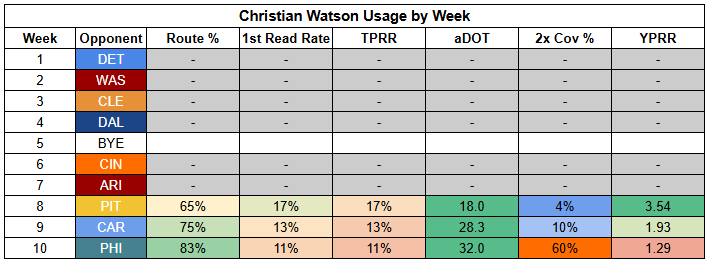
Last year, Watson had a 33% TPRR against man with 3.34 YPRR. This year, Watson has just a 10% TPRR against man, but a more promising 2.60 YPRR. More importantly, we don't really know what we have in him yet. Watson has been operating as an ultra-deep threat, making it difficult to draw consistent targets. But he's also been steadily ramping up in route participation, and the Eagles made him a focal point of their defensive game plan on Monday, so he's clearly not just doing cardio.
And as far as speculative deep threats go, Watson looks a lot more interesting than the guy keeping his deep threat seat warm for him.
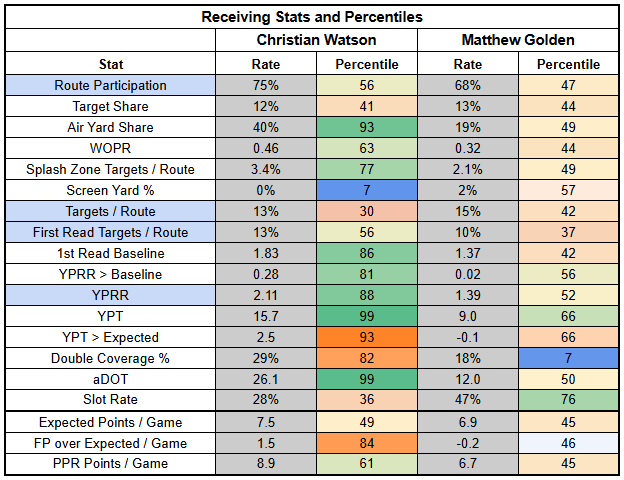
Matthew Golden has been limited in practice this week and looks to have a good chance of suiting up. His return would likely put Dontayvion Wicks back in a reserve role. Golden profiles as a dart throw if he plays, but adds more uncertainty to Watson's profile. Assuming Golden suits up, Watson is just a WR5.

Romeo Doubs exited early from Monday's game but has been practicing in full this week. He's good to go.
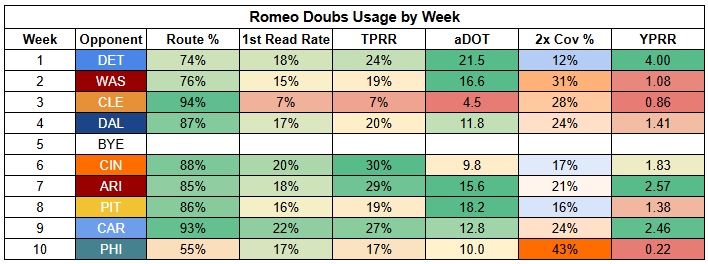
This matchup doesn't look to suit Doubs particularly well when down in the weeds of coverage and scheme. But he's the Packers' top target in a matchup where they should be efficient and productive.
The Packers have tended to get into trouble when they go against teams that can shut down what they want to do... because the Packers tend to still do what they want to do anyway. We've seen that pattern in all three of their losses.
But this isn't that kind of setup. This is a matchup where the smart way to attack is to lean on the run and take downfield shots as a secondary punch. That's exactly how the Packers want to play, and it should work quite well here. Targets are likely to be spread out, as usual, but Doubs can benefit from a strong day from Love as much as anyone. He's a high-end WR3.
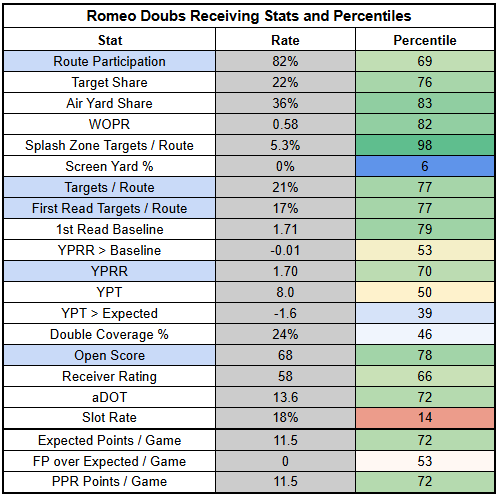
If Golden can't go, we'll likely see more of Dontayvion Wicks again this week.
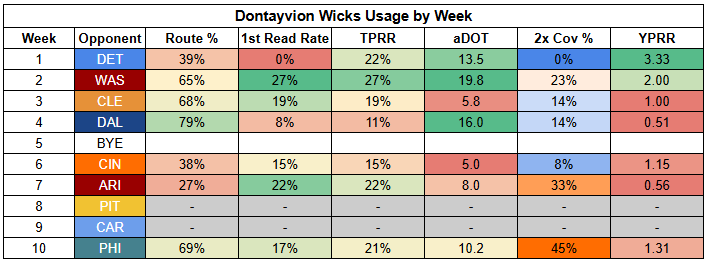
Last year, Wicks had a 37% TPRR against man; this year, he's at 36%. Unfortunately, Wicks had just 1.00 YPRR against man last year. His 1.81 YPRR this year is better, but still pretty weak given his target rate. Over the last two years, on a reasonably large sample of 41 targets, Wicks has just a 3.4 YPT against man coverage. And it's not like he's a little gadget player or something. He has a 15.2 aDOT with 37% of his targets traveling 20+ yards downfield against man.
Wicks is a pretty big positive regression candidate on this type of usage. If Golden is out and Wicks has a meaningful role, he should have a chance to redeem himself here.
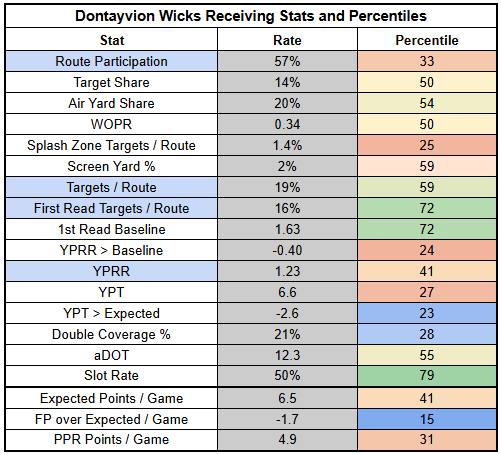
At tight end, Luke Musgrave filled in for Tucker Kraft last week and saw full-time usage. He didn't do much with his routes, though.

Musgrave's profile is weak, but he's still somewhat interesting as a bet on this offense. Given that Kraft was starting to emerge as a legit star, it's also a little less damning that Musgrave was benched for him. Musgrave probably belongs in the Michael Mayer tier of respectable backkups. Or, at least, that's the hope. He's a TE2.
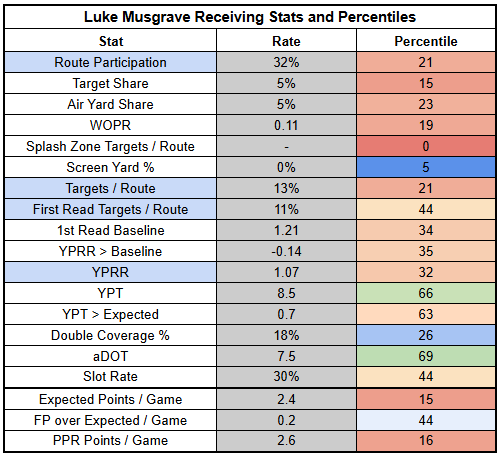
Giants
Implied Team Total: 17.75
Jaxson Dart will miss this game with a concussion, and Mike Kafka is taking over as interim head coach, with Brian Daboll out the door.
It's hard to know how Kafka will approach things... but we have one promising sign so far. The Giants are starting Jameis Winston over Russell Wilson.
This is really just a start, though—starting Winston isn't enough on its own. The critical thing to remember with Winston is that his production last year was largely a product of volume. Over the last two seasons, Winston has been less efficient than Russell Wilson and has produced negative EPA. This isn't necessarily a QB upgrade.
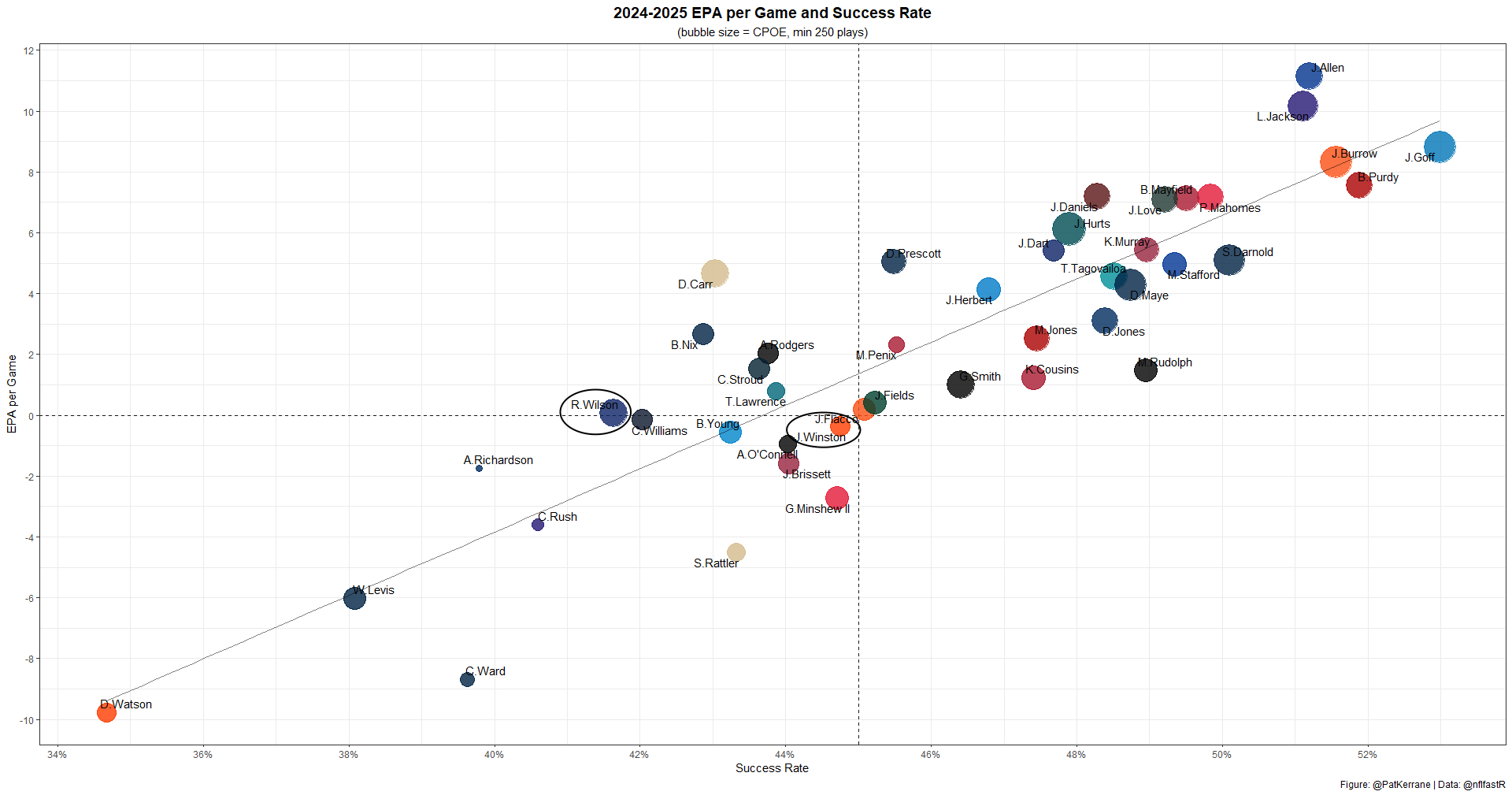
At the same time, I still view this change as quite bullish for the offense. We don't know exactly what we're going to get with Winston. With Wilson, we could be confident were weren't getting much in this matchup.
In retrospect, it's extremely telling that Wilson's only good start was against the Cowboys. Even against a weak Commanders' defense, he couldn't get anything going. And he was useless against a weak Bears defense last week.

So, kudos to Kafka for seeing if Winston can spark the offense with Dart out. But for Winston to actually deliver for fantasy, we also need dropback volume.
Winston started for the Browns from Week 8 to 15. His best passing lines were a 334/3 against the Ravens, 385/2 against the Saints, and 497/4 against the Broncos. The Browns had pass rates of 66%, 73%, and 75% in those games.
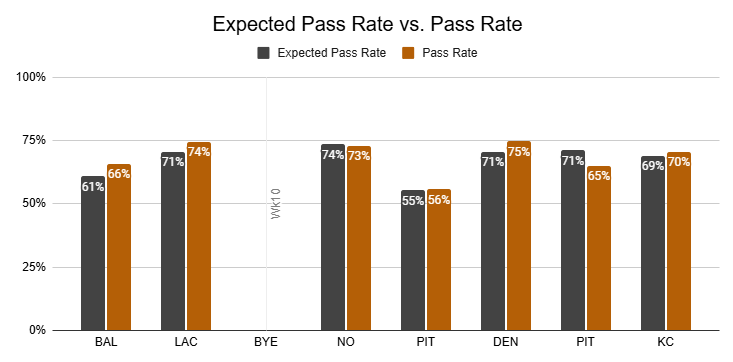
Currently, the Giants are averaging a 64% pass pass rate, but they were passing at a significantly higher rate with Wilson under center than with Dart.
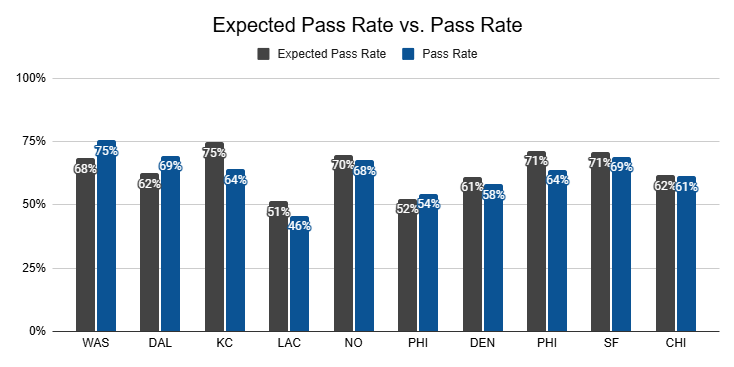
We could really use a return to that type of playcalling this week. Because, at baseline, we should expect a big drop-off in QB efficiency from Dart to Winston.
After breaking out against the Eagles, Jaxson Dart has been consistently efficient.

Dart currently ranks QB14 in EPA per game and QB15 in success rate. He's profiling as a very solid starter and very promising rookie; he's been much more impressive than Wilson was, despite not having Malik Nabers for most of his starts.

Winston represents a downgrade at baseline, but is also facing a Packers defense that is very solid, even if not as fearsome as we assumed after the Micah Parsons trade.
It's odd that the Packers don't rate better on defense. It's not like Parsons hasn't been good. He ranks EDGE6 in pass rush win rate and EDGE1 in pass rush grade. Karl Brooks also ranks DT13 in pass rush win rate, and Devonte Wyatt ranks DT16 in pass rush grade. So they have a pass rush. They also get home without blitzing. They're also very strong in coverage.
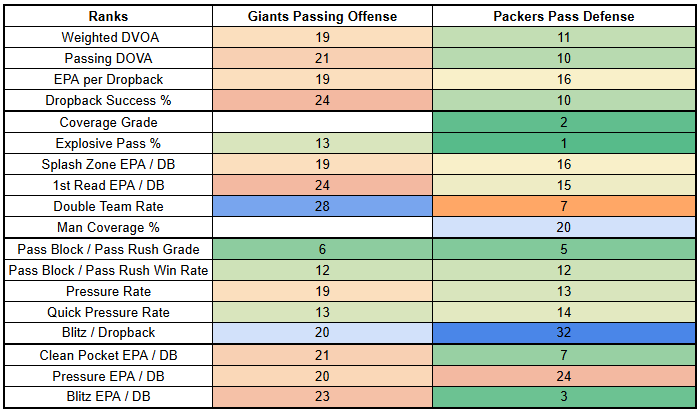
The Packers also have a good run defense. Theoretically, they should be able to regularly shut down opposing offenses. It's not like the Packers defense is bad, but it has potential to be held in the same regard as Seattle, Houston, or Denver, and it's a cut below right now.

In my view, part of the issue is that the Packers just don't push teams as much as you'd expect. They let them hang around, which means letting them play balanced. In turn, this lets opponents off the hook by generating fewer obvious passing situations for Parsons and company to attack. The numbers back this up. Packers' opponents have played with a lean to the run and are playing slowly. This isn't a team that is going to boat race you... so why not lean into the one-score game that Green Bay wants to play in (for some reason)?

My best guess is that we'll see the Giants work to stay balanced here for as long as possible, avoiding putting Winston in obvious dropback situations where the Packers can pin their ears back.
With a -1% PROE and a 5% PROE on 1st down, they've been prioritizing the pass in neutral situations but are run-first overall, especially with Dart under center.
Obviously, that could shift with Kafka calling plays and Winston at QB. But, Kafka has some serious onions if he's willing to build a pass-heavy game plan around Winston here. It'd be much more prudent to lean on the run and see if the Packers will let them play for a one-score game.
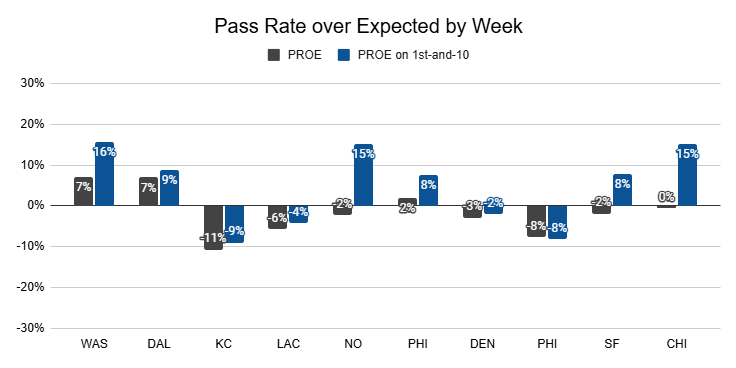
After ending up on the wrong end of a split in Week 9, Tyrone Tracy had a clear lead in the backfield last week, turning in his second-highest snap share of the season.

Devin Singletary siphoned off valuable touches but looked like the secondary back, as initially expected after Cam Skattebo's injury.
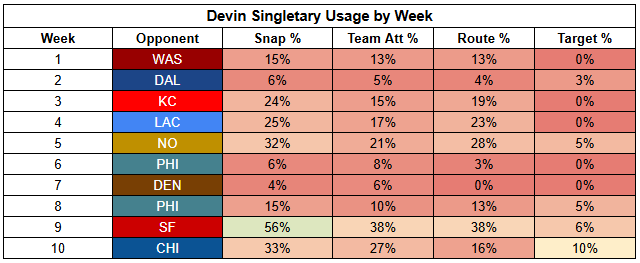
However, the lesson from Week 9 is that Tracy's role is pretty fragile. Especially with a new head coach, we can't take his usage for granted. Tracy just hasn't been good enough to earn that deference. He profiles an RB3.
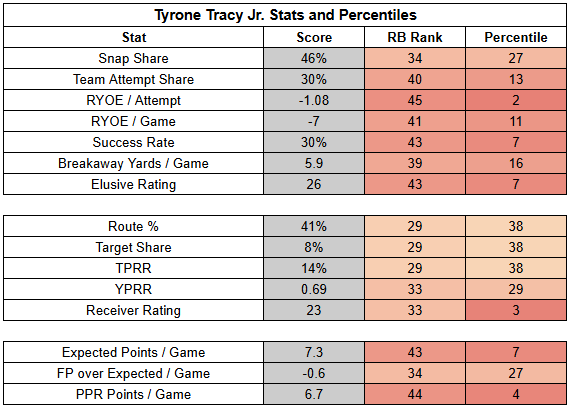
Speaking of fragility, Ray-Ray McCloud's stint as a full-time Giants WR lasted exactly one week.

Darius Slayon's usage continues to bounce around. And this week he's logged back-to-back DNPs with a hamstring injury. Even if he goes, he's a shaky dart throw.
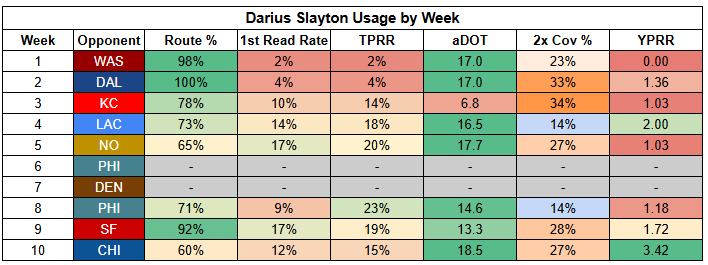
Even if the Giants try to stay balanced and avoid obvious dropback situations, the Packers are going against a very weak run defense and should be more potent on offense than we've seen recently. Even if overly conservative, they should be able to put TDs on the scoreboard, putting the Giants in negative game script.
That's potentially good news for Wan'Dale Robinson. Robinson has been operating as the clear-cut No. 1 since Malik Nabers went down and has shown more downfield ability than expected this year.

Granted, this week he may be in more of a quick-hitting role as the Giants contend with the Packers' pass rush, but one way or another, Robinson should be involved.
Especially with Slayton potentially out, it's hard to see how Robinson isn't heavily targeted this week. He's a high-end WR3.

Negative game script isn't really a plus here; it just serves to mitigate an otherwise unfortunate setup. Although not enough to put non-Robinson, non-Slayton WRs in the mix.
McCloud's playing time is uncertain; Gunner Olszewski might be the next man up. And I'm not interested in guessing between those two.
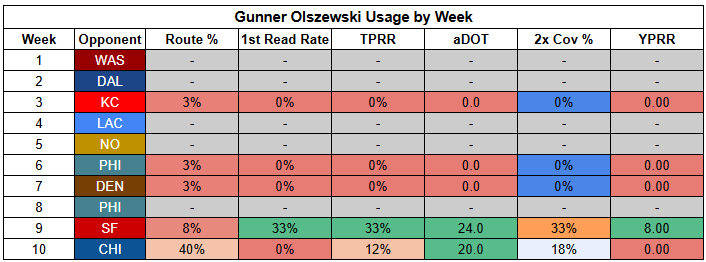
In the same sense, the potential for negative game script is a "boost" for Theo Johnson. But it's a boost relative to "I'm not really looking to play Giants this week." And even in weeks when I've been intrigued by the Giants, Johnson hasn't jumped off the page. He's a TE2.

Bears at Vikings, 1 PM
Bears
Implied Team Total: 23
This week, we should get a better idea of where exactly Caleb Williams stands—both as a QB and with Ben Johnson.
Williams has been much better over the last two weeks, with the Bears pulling out close victories. But Williams' improved efficiency is less impressive when you consider he was facing the Bengals and the Giants.
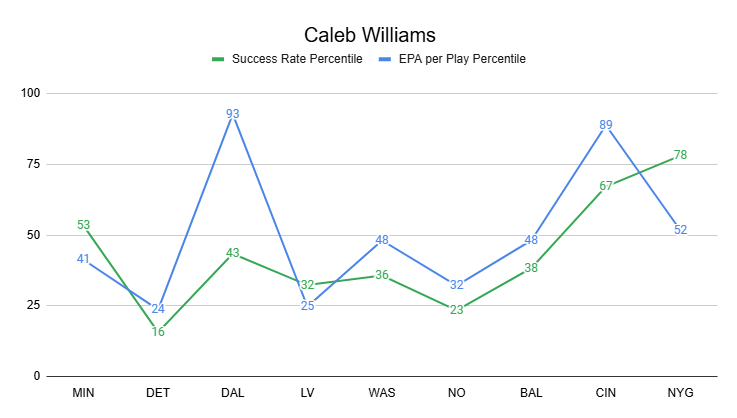
Williams remains a very inconsistent QB, ranking just QB27 in success rate. He's up to QB21 in EPA per game at least. He has big-play ability, but he's hard to count on from down to down.
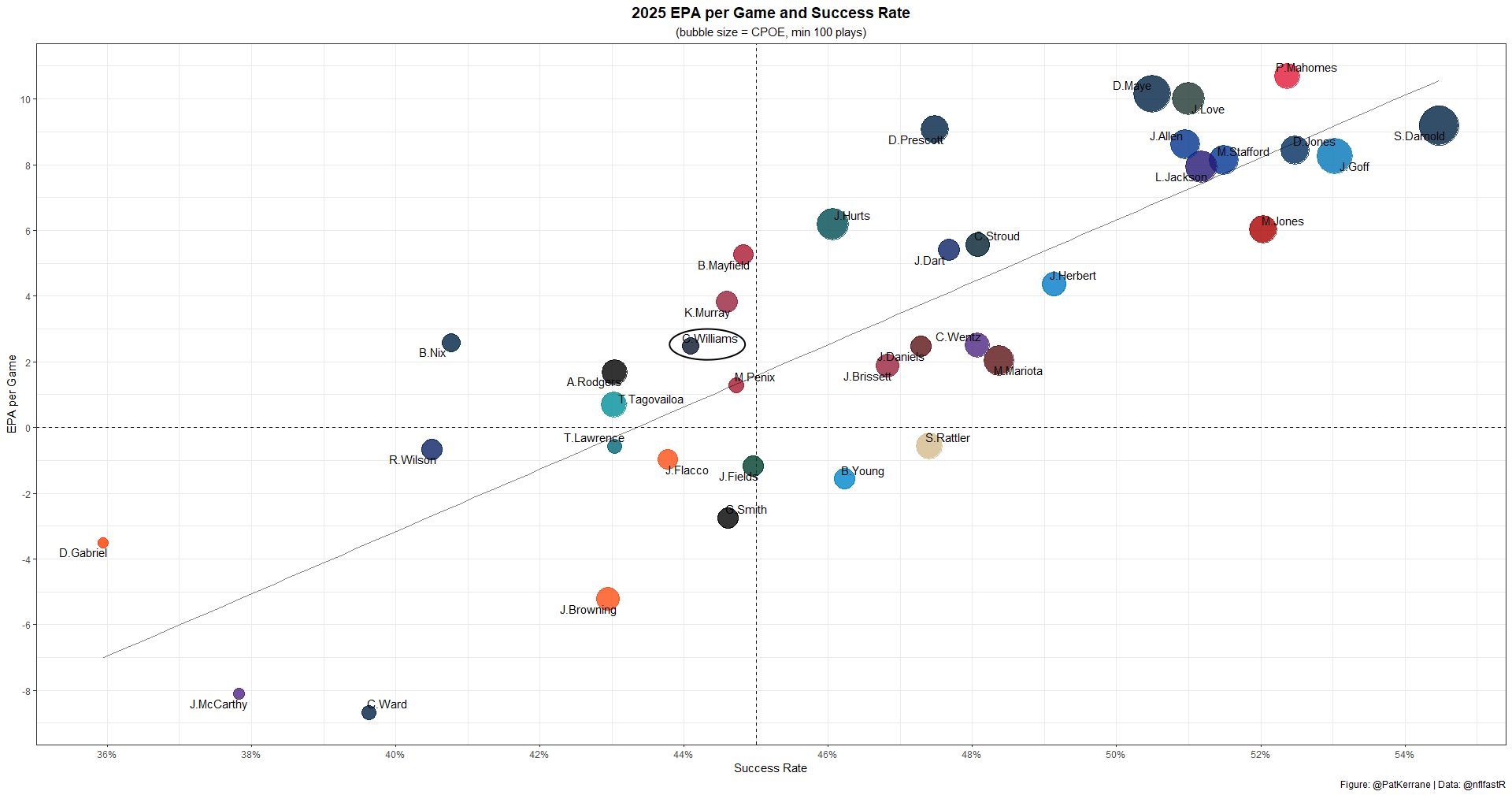
Williams' inconsistency is clearly tied to his outrageously long time to throw. Williams just averaged 3.64 seconds per throw against the Giants. He's now up to a 3.34-second time to throw—by far the longest in the NFL. Jalen Hurts (3.21) and JJ McCarthy (3.18) are the only other QBs at 3.1 seconds or higher.
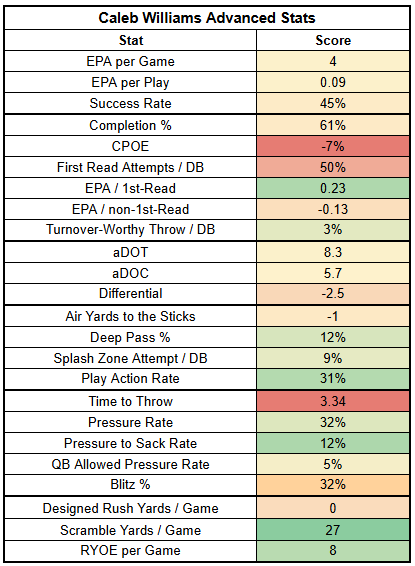
Williams is an aggressive downfield thrower and an effective scrambler, so his long time to throw isn't always a big concern. As we've seen over the last couple of weeks, he's quite capable of making plays after holding it for an eternity.
However, when a QB is facing the blitz, it's beneficial to be able to speed up, to adjust.
For example, Lamar Jackson has a lengthy 3.29-second time to throw on non-blitzed dropbacks. But Jackson speeds up considerably against the blitz, averaging just 2.71 seconds. Jackson has the second-highest success rate against the blitz this year—likewise, Patrick Mahomes' time to throw drops from 2.91 seconds to 2.61 seconds against the blitz. Mahomes has the highest success rate against the blitz this year.
Most QBs with high success rates against the blitz show the ability to speed things up, such as Matthew Stafford (2.79 vs. 2.45), Jared Goff (2.71 vs. 2.43), and Drake Maye (3.20 vs. 2.88).
Caleb Williams is speeding up as well, dropping from 3.44 seconds on non-blitzed dropbacks to 3.14 seconds against the blitz. But he's probably not speeding up enough. Only Tyrod Taylor (3.25) is taking longer against the blitz.
Williams now gets a Vikings defense that is blitzing at the highest rate per dropback and is generating pressure as quickly and consistently as any defense in the NFL.
This matchup should help clarify if Williams can play his game successfully against a scheme designed to speed him up. It should also help illuminate whether Williams has developed alternative tactics within the Ben Johnson offense, and whether he can adapt his game more than he's shown in a pretty soft run of recent matchups since kicking off his season against Brian Flores.
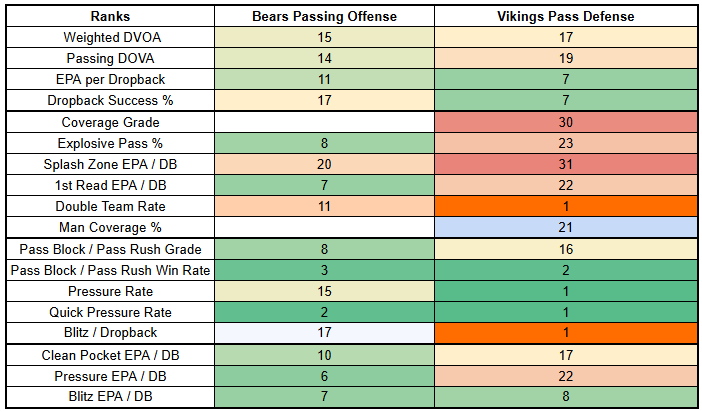
This matchup should also help us understand where Ben Johnson is at with Williams.
In Week 1, the Bears passed 68% of the time. They're now coming off the exact same pass rate. In both games, they were roughly in line with game script, but, crucially, were not fighting against script to establish the run—especially notable because both opponents, the Vikings and Giants, are run funnel defenses.
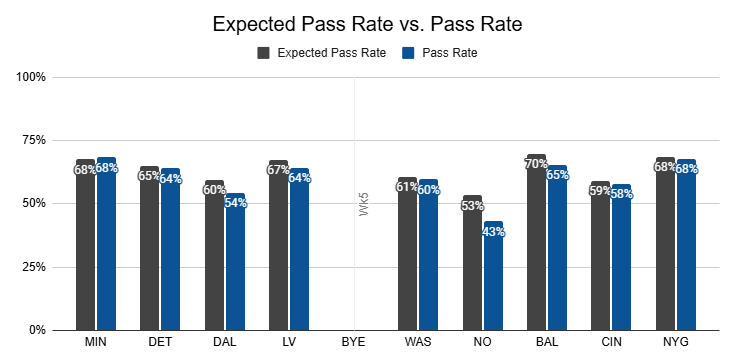
We've seen Ben Johnson pass on this defense before. It's possible he trusts Williams to overcome this matchup and will lean on him rather than attack the way teams usually do against Minnesota.

However, I have a hard time imagining Ben Johnson was happy about having to turn Williams loose last week. It was in the context of trailing 17-7 early in the 3rd quarter and 20-10 early in the 4th.
Of course, the Bears are 2.5-point road underdogs this week... they could easily be trailing again.
Moreover, the Vikings' run defense isn't really that bad. Teams are mostly running on them to ease defensive pressure.

If the Bears have the chance to run the ball and play from ahead, I expect Johnson to leap at the opportunity. That opportunity looks like it would go to D'Andre Swift, who retook control of the Bears' backfield last week.
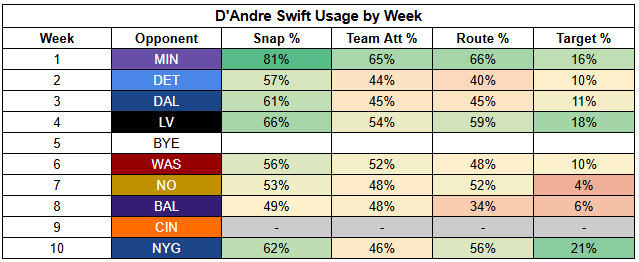

Swift has run well this year, while also providing value in the receiving game. His role looks insulated from game script and he should be in his normal rushing role. He's an RB2.

But while Swift is a solid fantasy play this week, he's unlikely to be a dominant factor. If JJ McCarthy melts down, sure, Swift can feast on a strong workload. But he's unlikely to tilt this game on his own.
If the Vikings can push Chicago, Williams will need to step up.
And, it's not like Williams is doomed here. He's going to face more quick pressure than usual, which is a concern. But he's been pretty good against it, ranking QB8 in EPA per play and QB7 in success rate. Williams succeeds against quick pressure, as he always does—by being himself. Williams has an absurd 3.97-second time to throw under quick pressure, easily the longest in the league. But he has some good company here. Josh Allen (3.65), Jaxson Dart (3.65), and Drake Maye (3.55) are the only other QBs over 3.5 seconds.
I bet you can picture these plays—quick pressure off the edge and the QB sees it right as he reaches the end of his drop; he makes a quick move to avoid the defender, then scoots up and runs out of the side of the pocket; he continues to look downfield while outrunning the trailing defender before finally throwing to a receiver along the sideline.
This is a perk of this type of QB, especially when going against a weak secondary. This feels like a good time to mention that the Vikings rank 30th in coverage grade and are allowing explosive plays at the 10th-highest high rate.
Ultimately, though, I do think this is a matchup where Williams could have some fun moments but will largely struggle. It's just that he's shown enough recently that I'm not as confident in him struggling here I would have been a few weeks ago. There's also the possibility that he struggles for most of the game and then flips a Bo Nix-style switch and makes plays down the stretch.
But I'd be more scared of Williams proving me wrong if I felt better about Rome Odunze's matchup.
Odunze is coming off a matchup with a Giants defense that plays a ton of man and doesn't double cover at a high rate—a pretty nice setup for a man-beating No. 1 WR. But Odunze now gets a Vikings defense that doesn't play much man coverage and double-teams at the highest rate in the NFL. Odunze is a deep threat and the Bears' clear No. 1; taking him away is the obvious move.
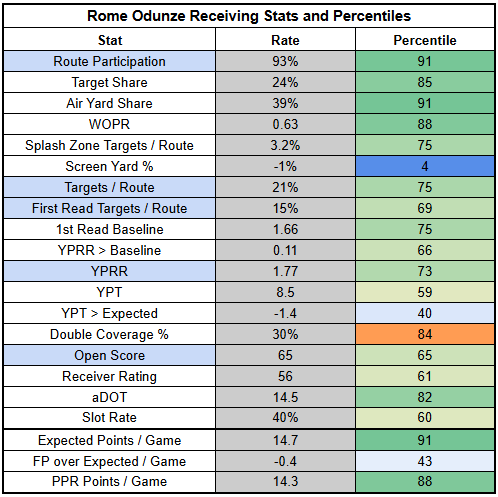
That's the way the Vikings played it (successfully) in Week 1, and that was before it was clear how critical Odunze is to this passing game. Given the matchup and his stretch of poor production before last week's rebound, Odunze is a high-end WR3.

DJ Moore showed some life against the Ravens and Bengals, but he was held without a catch against the Giants. Moore was limited with a shoulder injury he suffered in the 2nd quarter, which cost him playing time. But he did eventually return to the game in the second half.
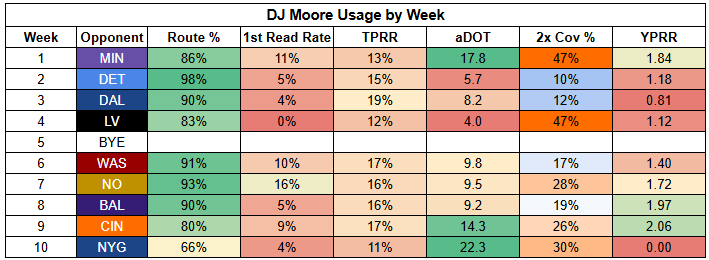
After logging a DNP/LP in practice this week, Moore probably plays. But if he's limited or out, Luther Burden looks like the clear next man up. Olamide Zaccheaus remained in his regular role last week, while Burden saw a significant increase in routes with Moore injured.


If Burden takes on a bigger role this week, I'd honestly be more optimistic about the passing game. He's flashing big-play upside, which is how you make a defense pay if it's laser-focused on bringing heat and taking away first reads.

Neither Moore nor Zaccheaus is striking fear into defenders' hearts.
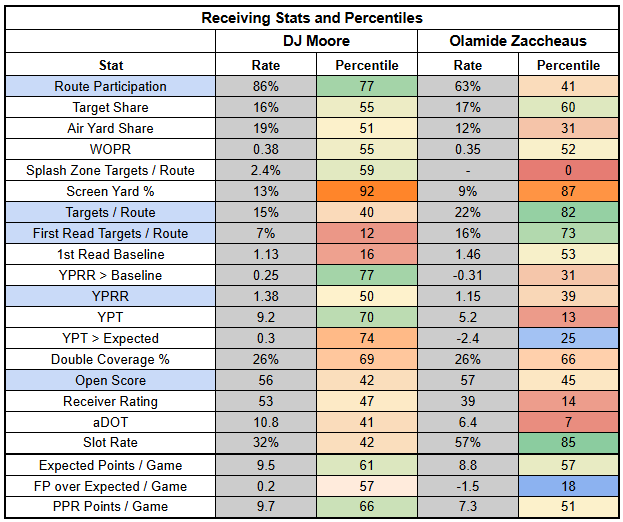
Like Burden, Colston Loveland looks capable of stepping up as a downfield playmaker. He's been a stronger target earner than Cole Kmet and much more efficient when targeted. He looks like a potential difference maker.
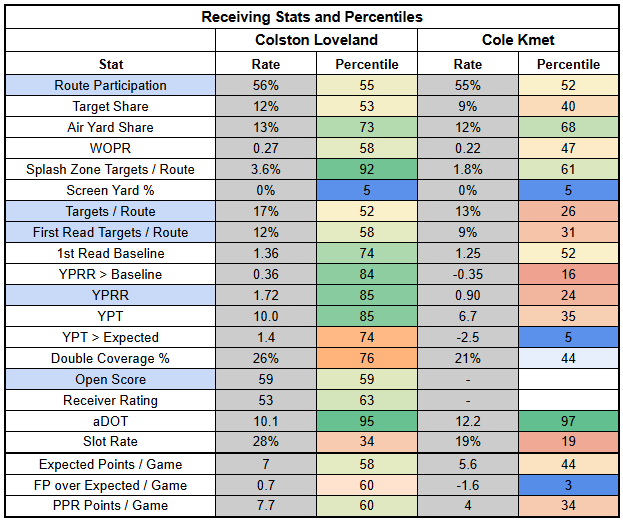
Unfortunately, tight ends can't make much of a difference if limited to half the routes. And, somehow, that's still where we're at with Loveland, who was splitting time with Cole Kmet last week.
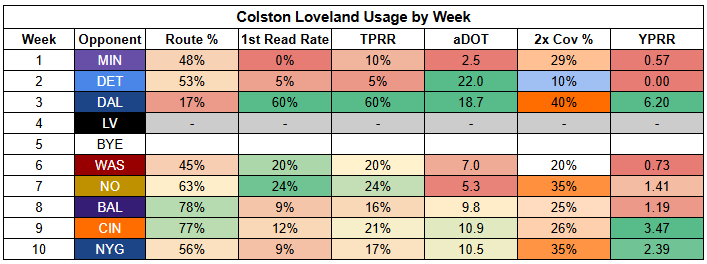
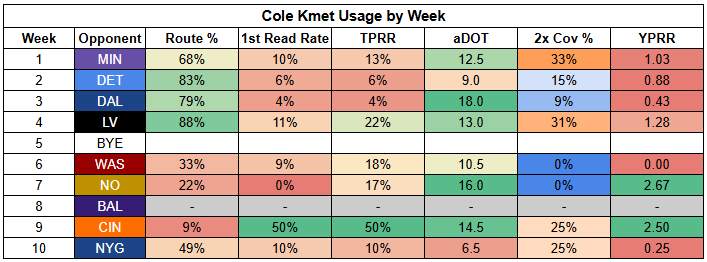
With his routes back in question, Loveland is just a TE2.
Vikings
Implied Team Total: 25.5
I'm pretty stats-oriented in my approach to football analysis. But sometimes... the good old eye test can save a lot of time. And, it might be time for the Vikings to open their eyes.
JJ McCarthy's approach to seemingly every throw is to rip a 99-mph fastball. It's like, hey, JJ, this isn't Speed Pitch at the fucking carnival, bro. Stop trying to conjure nine(s) and throw a catchable ball once in a while.
Watching McCarthy against the Ravens, a matchup where he faced quick pressure on only 23% of his dropbacks—in line with the league average—it wasn't hard to understand why McCarthy was playing poorly.
The stats weren't any more impressed than I was.
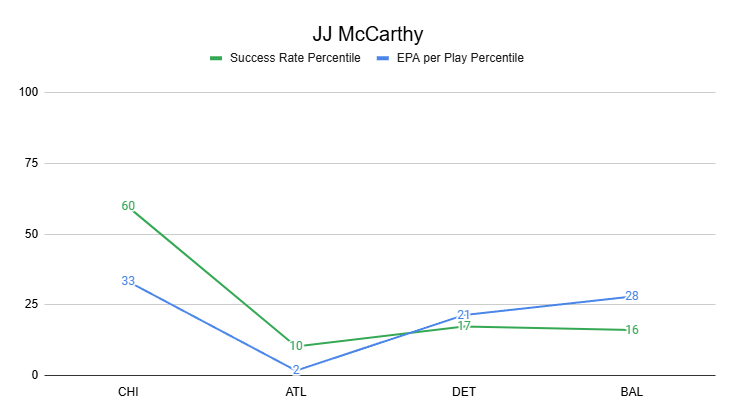
If we zoom out and look at the bigger picture, McCarthy's season looks more concerning, not less. He's peaked at just the 33rd percentile in EPA per play and currently ranks second-worst in EPA per game ahead of only Cam Ward. He's also second-worst in success rate ahead of only Dillon Gabriel.
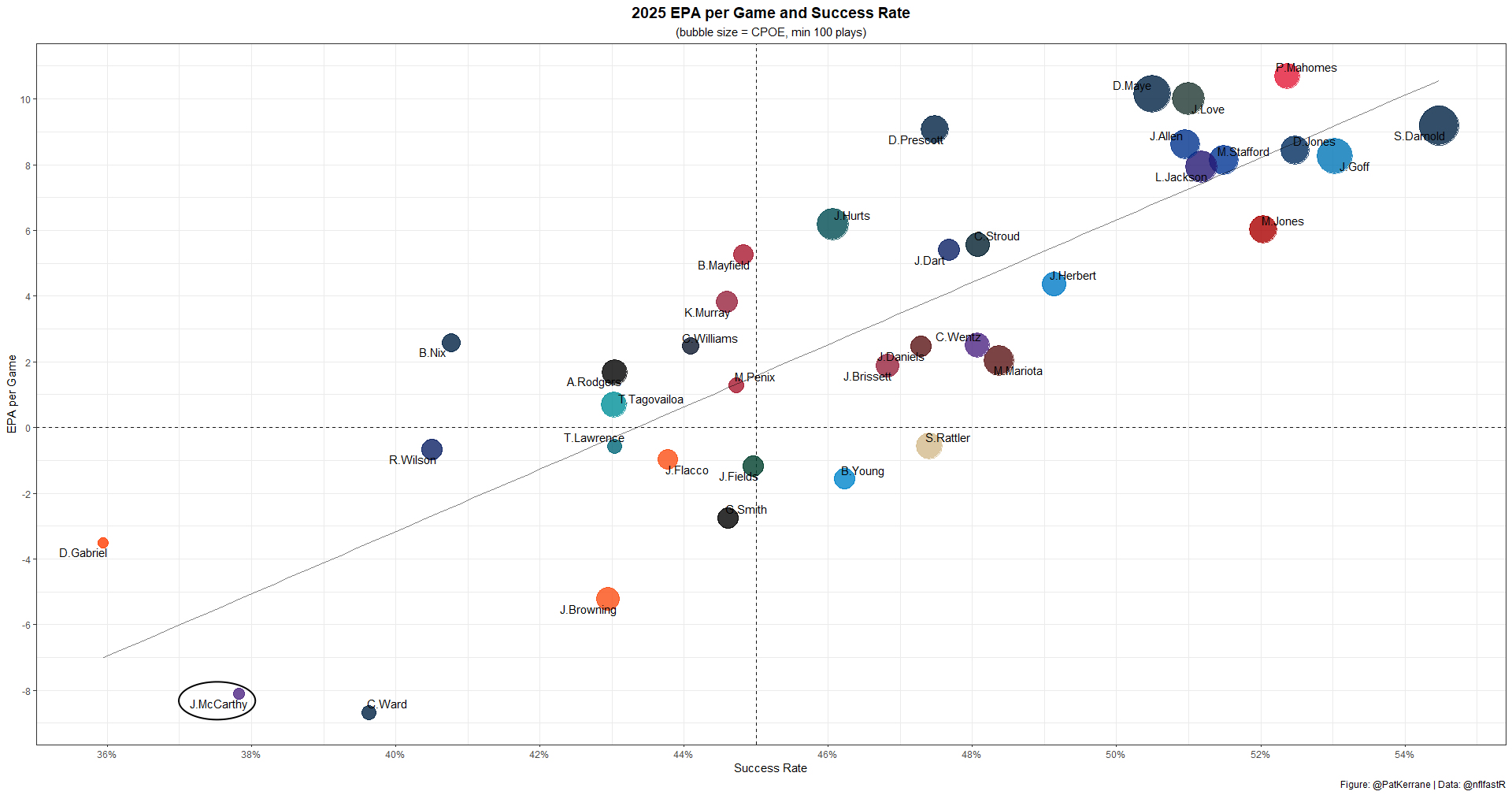
However, McCarthy now gets an extremely soft matchup against the Bears' defense. They are generating quick pressure at the lowest rate in the NFL, and two of their starting cornerbacks, Jaylon Johnson and Kyler Gordon, are on injured reserve. Outside corner Tyrique Stevenson is healthy, but out of 108 CBs with 150+ defensive snaps, no one is allowing more yards per coverage snap. Reserve CBs Nahshon Wright and Nick McCloud rank 76th and 91st, respectively. The Bears don't get pressure and are extremely vulnerable on the backend—significantly more so than in their Week 1 matchup with the Vikings.
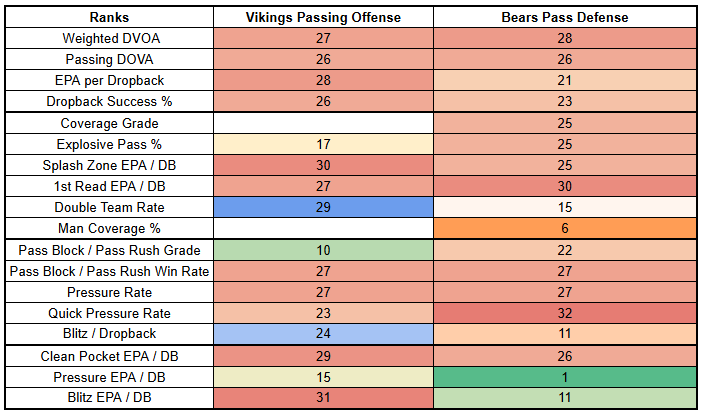
And while last week was a pretty frustrating watch if you were hoping McCarthy would show more than he had so far... it's worth noting that we did see quite a lot of him. Kevin O'Connell did not shy away from the passing game last week, with the Vikings posting their highest pass rate of the season.
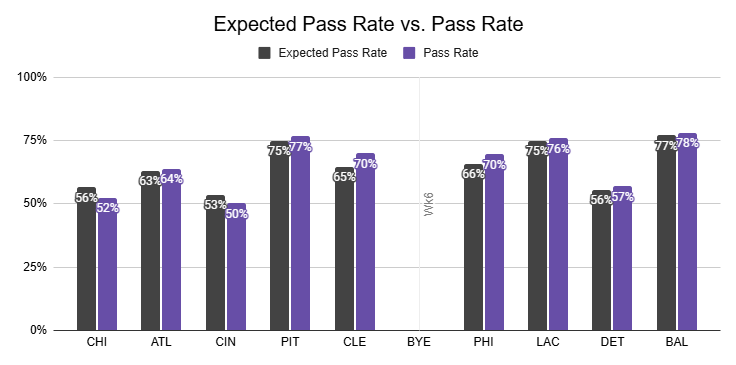
This matchup sets up somewhat similarly to last week in terms of offensive upside, but for different reasons. Last week, McCarthy got an unimposing pass defense in a game environment capable of generating passing volume.
This week, he gets a significantly easier matchup, but in a game environment that could be less passing-oriented.
The Bears actually profile as a bit of a run funnel.

This effect is easy to understand; the Bears aren't good against the run.

With the Bears potentially going run-heavy or struggling to sustain drives in a tough passing matchup, the Vikings should be able to call a more balanced game than last week.
O'Connell signaled that he was hoping for a more run-oriented game environment against the Ravens, with a -13% PROE on 1st down. McCarthy's opening start against the Bears is the only time the Vikings have been lower.

However, I'm down to trade some dropback volume for more efficient overall offensive output. And we could definitely see that here. The Bears are bad against the pass, the run, and the fake run. Teams have been aggressively play actioning against them, and the Bears aren't stopping it well.

The Vikings' pass game could have some fun moments this week. But predicting exactly who will be involved in those moments is slightly tricky.
TJ Hockenson has been a complete afterthought this year, to the point that I'm expecting a classic post-season injury report. Rapsheet reports that Vikings TE TJ Hockenson was playing with just one quad in 2025. He's expected to be a full participant in OTAs... or something like that.

With Hockenson not really in the mix, you'd think that targets would be condensed.

Typically, they are. However, Jalen Nailor popped up for a 5/124/1 receiving line against the Ravens out of freaking nowhere.
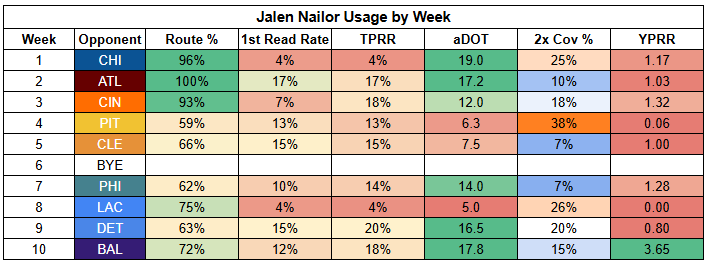
If we're going to invest in a suspect QB, we'd really like to know where the targets are going. We want those targets funneled to Justin Jefferson and Jordan Addison, and basically no one else. Despite the QB play, both WRs are playing well.

If the Vikings utilize a more balanced attack with more of a play action element, that should help both Jefferson and Addison.
With McCarthy, Jefferson is averaging 25% TPRR but just 1.42 YPRR on non-play action dropbacks. Those numbers jump to 28% and 2.03 on play action. For the season, Jefferson is at a 24% TPRR and 2.17 YPRR on play action. He's a high-end WR1.
Addison has a very small sample with McCarthy, but has a 20% TPRR on play action with 1.96 YPRR this year, compared to 16% and 1.56 on non-play action, so this week's offensive approach could be beneficial. He's a high-end WR3.
Of course, if the Vikings lean on the run more this week, that will benefit the run game most directly.
Aaron Jones dominated snaps against the Ravens, but when the Vikings were playing from ahead against the Lions, Jordan Mason saw more carries.

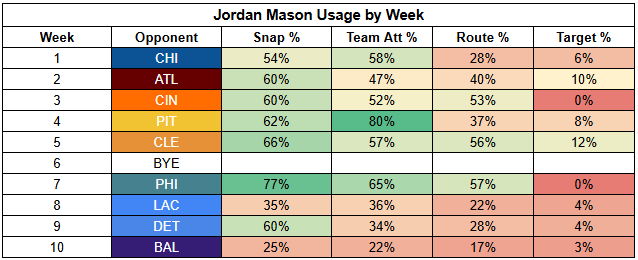
Jones' role looks more locked in, but his upside is hard to get excited about—we're likely to see plenty of Mason if the Vikings execute a balanced game plan. Jones is a low-end RB2, while Mason is an RB4.
Buccaneers at Bills, 1 PM
Buccaneers
Implied Team Total: 21
Baker Mayfield is coming off a non-disastrous game against the Patriots, but ultimately, another disappointing outing. Maybe it's unfair to expect him to put the entire offense on his back. But after watching him do that in multiple games, it's hard not to raise your expectations.
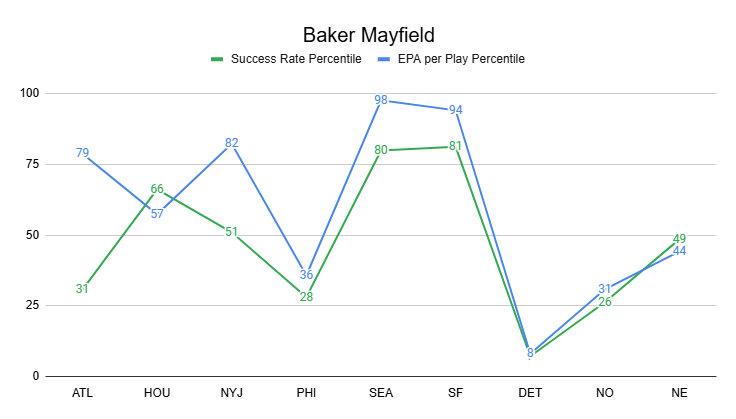
Mayfield currently ranks QB15 in EPA per game but just QB23 in success rate. He's profiling like a more efficient version of Caleb Williams, where, at his best, he's able to win games, but he's also harder to trust than you'd typically expect for a QB playing this efficiently.
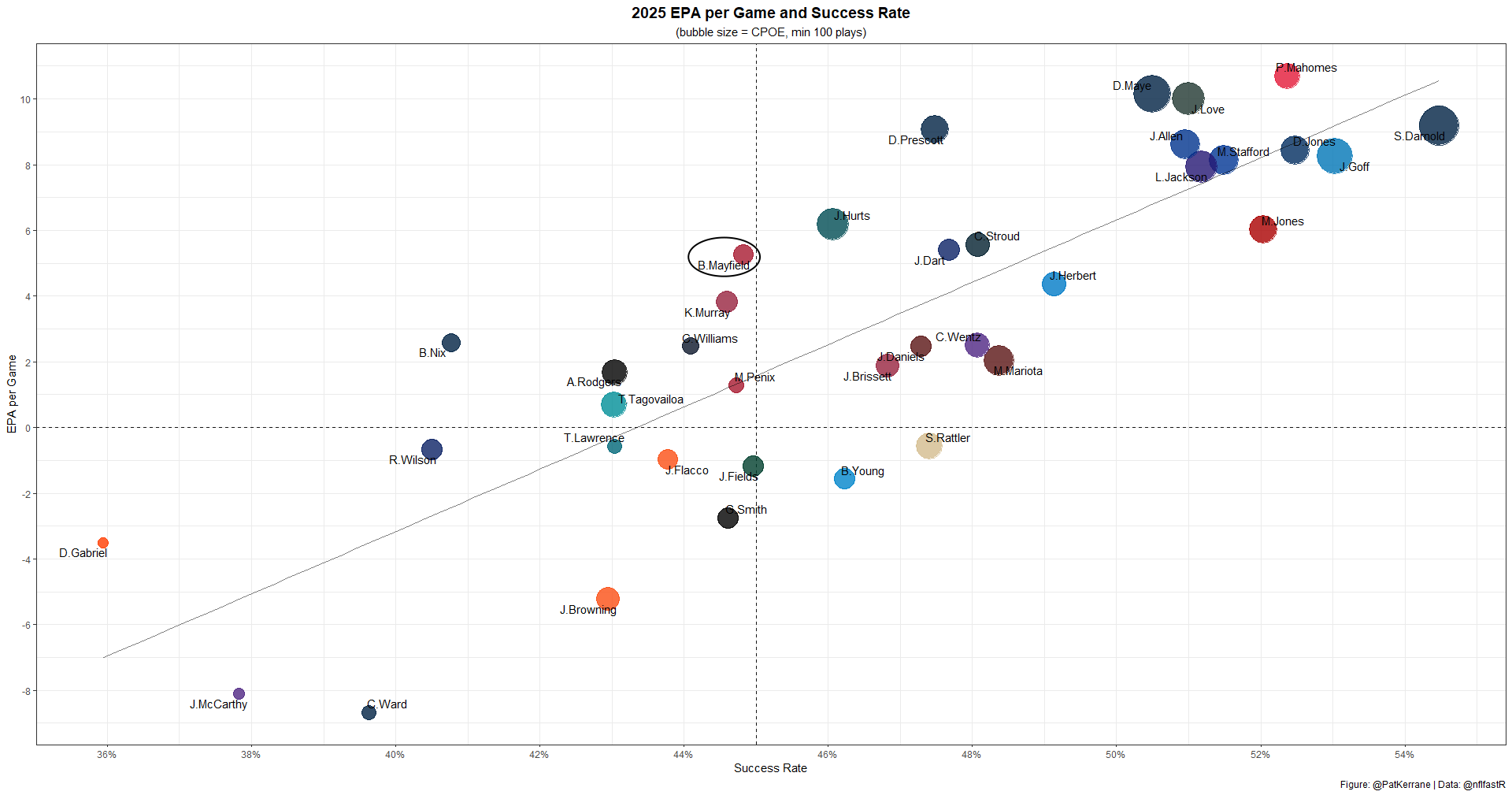
The big difference between Mayfield and Williams is that Mayfield posted elite efficiency against an elite Seahawks defense. He's not a schedule merchant. He's also had to overcome significant injuries along the offensive line and to his playmakers.
Unfortunately, the injury train keeps rolling. LG Ben Bredeson injured his hamstring against the Patriots and has logged back-to-back DNP this week. The Bucs are already thin at guard with Cody Mauch on injured reserve, although they should have Luke Haggard back this week.
The Bucs are also unlikely to have Bucky Irving back this week, who has been limited in practice. If Irving unexpectedly suits up, he would shift this matchup in some important ways.
The Bills are a massive run funnel.

The Bills are very poor against the run, and on offense, rather than aggressively working to score points with Josh Allen at QB, they have been confusingly conservative, inviting opponents to attack their defensive weakness by allowing them to play in run-friendly scripts.

Mayfield has been the key to the Bucs' success this year, but they aren't profiling as a pass-first team. They have a 63% pass rate, just above the league average. But this is primarily due to game script. They have a -1% PROE.

Moreover, the Bucs have been conservative on 1st-and-10 with a -4% PROE. They're now traveling to Buffalo, where there is a strong chance of sustained 15-20 mph winds for this game. This is an offense that will likely look to attack the Bills on the ground.
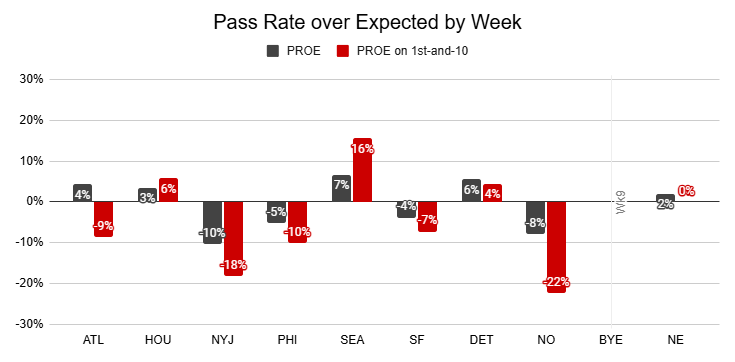
So, if Irving ends up playing, I'd be pretty excited about that. This is an environment where we can expect the Bucs to open the game with a run-first approach, and a matchup where we can expect rushing efficiency. If he goes, even with the potential for a limited workload, Irving would be a low-end RB1.
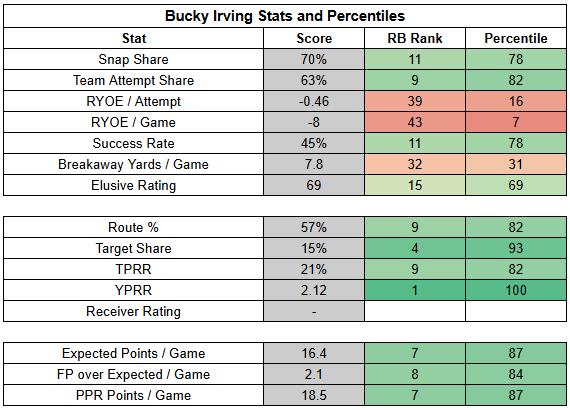
Assuming Irving is out, Rachaad White will operate as the lead back, from a snap share perspective, at least. His grip on carries is far more tenuous than his grip on snaps. Sean Tucker has forced a carry split over the last two games.

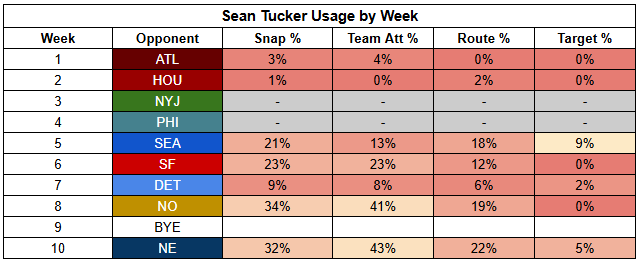
Rachaad White has been a very inefficient runner this year. He has upside for receiving utility if the Bucs play from behind as 5.5-point road underdogs. But it's hard to see the Bucs leaning on him in the run game. He's a high-end RB3.
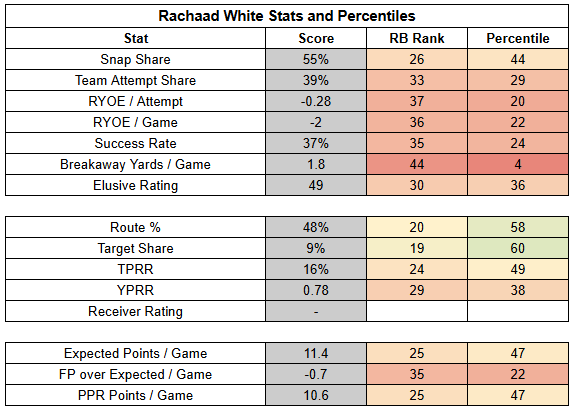
Sean Tucker actually has some appeal in this matchup as an RB4. With 15 RYOE this year, he's been adding more value in the run game than White (-28). He's mostly a bet on a TD, though.
In the passing game, we can expect the Bills to focus on taking away Emeka Egbuka. They have been double covering at a high rate. They've also been pressuring effectively, which could be a problem for Mayfield with the offensive line still not at full strength.
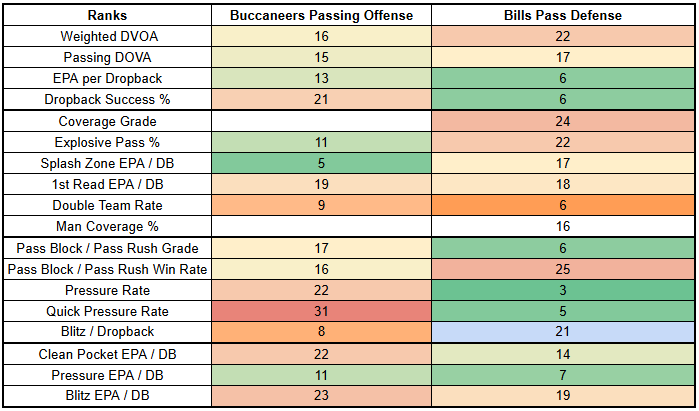
Egbuka is no stranger to double coverage. Teams have been working to take him away for weeks. When he was playing through injury, that worked. After a bye week to recover, though, he was far more effective against the Patriots.
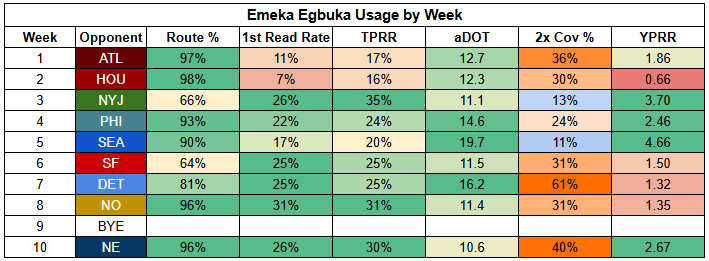
As I mentioned last week, Egbuka's profile looks legit—he's no longer a negative regression candidate. And that makes him a WR1.
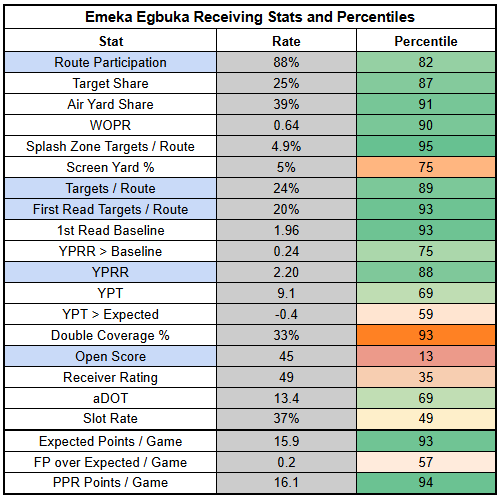
Behind Egbuka, the Bucs are unlikely to have Chris Godwin back this week; he's been limited in practice and is probably still a week away. That leaves Tez Johnson in place as the No. 2 WR.
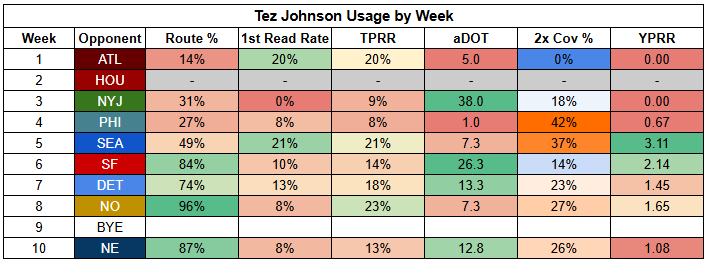
Sterling Shepard will have a role as well.
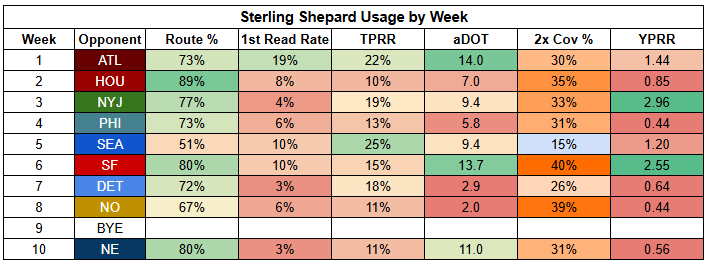
With Johnson's route particpation more locked in than Shepard's, he's a WR4 as a bet on Baker Mayfield elevating in a potentially high-scoring game environment. Shepard is a dart throw.
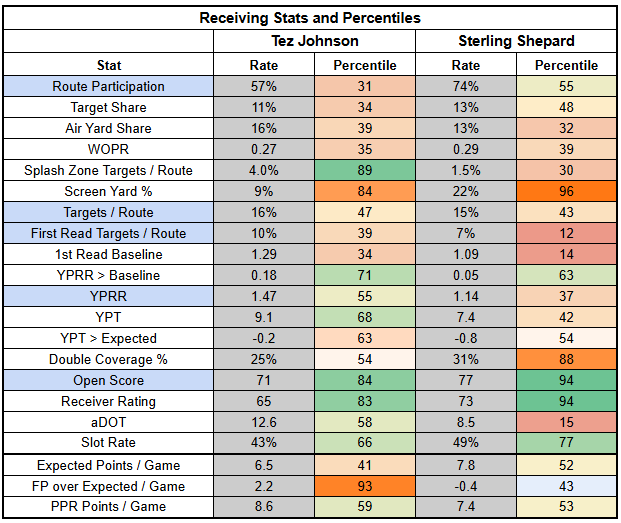
Cade Otton will also be out there—he always is. Otton's 88% route participation ranks 97th percentile at tight end. He's mostly a bet on that route volume, but in this game environment, he's a high-end TE2.



